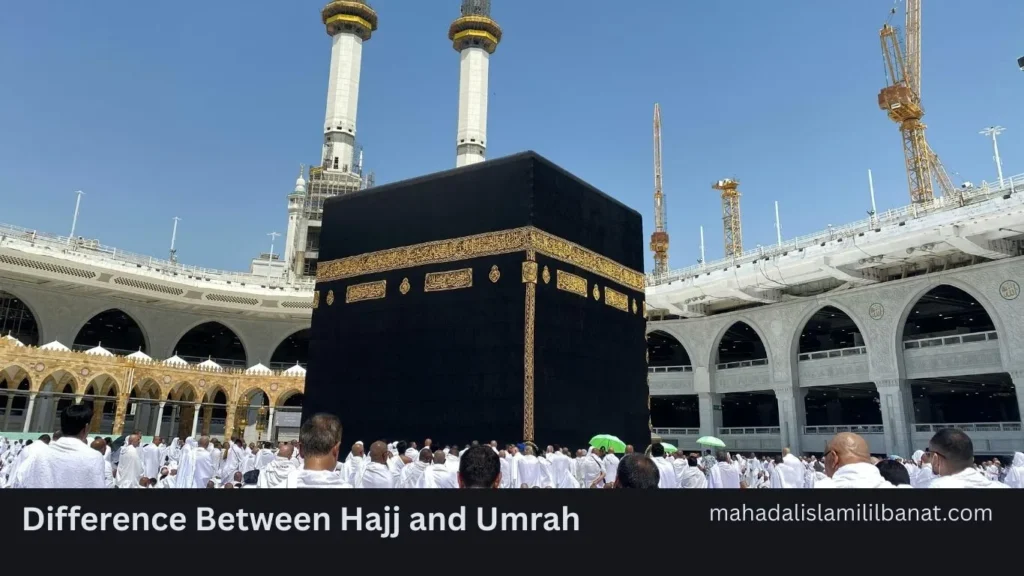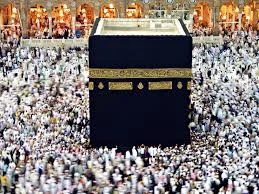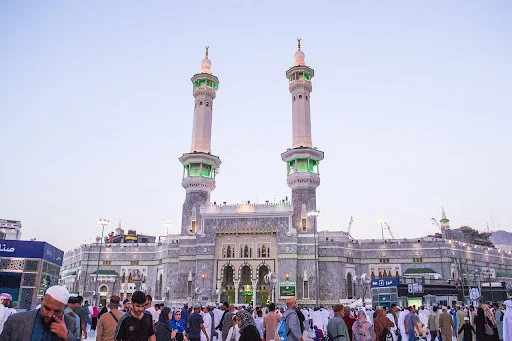Understand the Difference Between Hajj and Umrah
It is important to understand the difference between Hajj and Umrah because both are prominent pilgrimages in the Islamic religion. Muslims need to perform the pilgrimage in Mecca, which involves rituals reflecting a deeper sense of spiritual renewal and devotion. There are some aspects, but also different key elements. Hajj is a longer and deeply communal pilgrimage, while Umra is a flexible and shorter pilgrimage.
Hajj is one of the five pillars of Islam, which is obligatory for every adult Muslim who is financially and physically able to perform at least once in their life. Muslims have to perform Hajj annually in the Islamic month of Dhul-Hijjah. There are specific days for rituals, making it non-negotiable with the fixed time.
Umrah is a non-mandatory pilgrimage that is performed anytime during the year. Both pilgrimages involve a state of Ihram, performing Tawaf, and Sa’i. Tawaf is a circumambulation of the Kaaba, and Sa’i is walking between the Safa and Marwah. Hajj consists of additional rites such as standing at Arafat and symbolic stoning of the devil. You can learn details, including the rituals and rites, from an online Quran academy.

What is Hajj in Islam?
Hajj is a prominent act of worship for Muslims. This significant pilgrimage encourages Muslims to undertake at least once in their life. It holds deeper religious and spiritual significance for Muslims globally. This pilgrimage takes place in Mecca during the 12th month of the Islamic calendar.
Hajj is a transformative and spiritual experience for Muslims who want to come closer to Allah Almighty. Muslims across the world travel to Mecca (Makkah), located in Saudi Arabia, to enhance their faith while purifying their soul through a series of rituals and rites.
These rituals consist of 7 times Tawaf and Sa’i. Moreover, another difference between Hajj and Umra is standing at the Arafat for supplication and reflection while asking forgiveness from Allah Almighty. It is a great source of unity, humility, and submission to Allah Almighty. The Quran in English says:
فِيهِ ءَايَٰتٌۢ بَيِّنَٰتٌ مَّقَامُ إِبْرَٰهِيمَ وَمَن دَخَلَهُۥ كَانَ ءَامِنًا وَلِلَّهِ عَلَى ٱلنَّاسِ حِجُّ ٱلْبَيْتِ مَنِ ٱسْتَطَاعَ إِلَيْهِ سَبِيلًا وَمَن كَفَرَ فَإِنَّ ٱللَّهَ غَنِىٌّ عَنِ ٱلْعَٰلَمِينَ
“In it are clear signs and the standing-place of Abraham. Whoever enters it should be safe. Pilgrimage to this House is an obligation by Allah upon whoever is able among the people. And whoever disbelieves, then surely Allah is not in need of any of His creation.” Surah Ali ‘Imran (97)
Hajj has become a religious duty, allowing Muslims to renew their faith while coming close to Allah Almighty and purifying their hearts. Therefore, it’s a spiritual lifetime journey for every financially stable Muslim.
What is Umrah?
Umrah is a shorter and more flexible pilgrimage, encouraging Muslims to perform at any time in their lives. Moreover, it is a voluntary pilgrimage with greater spiritual importance. Muslims have to visit and experience the sacredness of the Kaaba while enjoying the benefits of Ayatul Kursi.
Umrah allows Muslims to ask forgiveness while establishing a stronger spiritual connection with Allah Almighty. It is important to remember that the Holy Prophet Muhammad (PBUH) performed many Umrahs, showcasing the spiritual importance. It is narrated:
“The Prophet (PBUH) performed four Umrahs: three in Dhul-Qa’dah, apart from the one he performed during his Hajj. These included the Umrah from Al-Hudaybiyah, the one the following year, the Umrah from Al-Ji‘rana where he distributed the booty from the battle of Hunain, and another Umrah with his Hajj.”
It demonstrates the significance of the Umrah as a Sunnah and a personal spiritual experience, encouraging Muslims to perform this voluntary pilgrimage.
How is Umrah Performed?
Shaykh Ibn Uthaymin explained the entire process of performing this pilgrimage by entering the ihram at the miqat. You need to follow important steps to achieve ideal performance while understanding the difference between Umrah and Hajj.
Entering Ihram and Ghusl
It is important to understand how to perform Ghusl for females and males before entering the Ihram. This ritual purification is a Sunnah for both women and men before starting the spiritual journey. Men can also use perfume on their beard and head before wearing the Ihram (two simple white cloth pieces: izar for the lower body part and rida for the upper body part). Women can also wear permissible clothing that covers their bodies.
The pilgrim needs to perform a necessary prayer, either a Nafl or a time for one obligatory prayer, after performing the ablution. However, there is no particular prayer for entering the Ihram because the Holy Prophet (PBUH) did not prescribe it. It is important to note that women in Nifas do not perform the prayer. Moreover, you can learn when was the Quran written.
Reciting the Talbiyah
The pilgrim must start reciting the Talbiyah after entering Ihram “Labbayk Allahumma Umratan. Labbayka Allahumma labbayk, labbayka la sharika laka labbayk. Inna al-hamda wa’n-ni‘mata laka wa’l-mulk, la sharika lak.”
“Here I am, O Allah, for Umrah. Here I am, O Allah, here I am. Here I am, You have no partner, here I am. Verily all praise and blessings are Yours, and all sovereignty, You have no partner.” It is necessary to continue the recitation of Talbiyah until reaching Mecca.
Entering Makkah and the Masjid Al-Haram
It is a good approach to perform ghusl when entering the Makkah because it is the Holy Prophet (PBUH)’s sunnah after understanding the difference between Hajj and Umrah. You can consider an Islamic education course to learn the essential rituals for Umrah. The pilgrim enters the right foot in Masjid Al-Haram and recites: “Bismillah wa’l-salatu wa’l-salam ‘ala Rasulillaah. Allahumma ighfir li dhunubi waftah li abwab rahmatika. A‘udhu Billah il-‘azim wa bi wajhihi’l-karim wa bi sultanihi’l-qadim min al-shaytan il-rajim.”
“In the name of Allah, and peace and blessings be upon the Messenger of Allah. O Allah, forgive my sins and open to me the gates of Your mercy. I seek refuge in Allah the Almighty and in His Noble Face and in His eternal Power, from the accursed Shaytan.”
Tawaf (Circumambulation of the Ka’bah)
The pilgrim must begin Tawaf at the Hajar Al-Aswad (Black Stone), kissing it or pointing towards it while reciting “Bismillah wa Allahu akbar. Allahumma imanan bika wa tasdiqan bi kitabika wa wafa-an bi ‘ahdika wa ittiba‘an li Sunnati Nabiyyika Muhammad sall-Allahu ‘alayhi wa sallam.”
“In the name of Allah, and Allah is most great. O Allah, out of faith in You, and in belief in Your Book, and in fulfillment of Your covenant, and following the Sunnah of Your Prophet Muhammad (PBUH).”
You can explore the Quran prayer course to make supplications during Tawaf. Moreover, you must perform Tawaf seven times with the Ka’bah on your left side. You can touch the Yemeni Corner and Black Stone following the Sunnah.
Important Points during Tawaf
The men must take shorter steps and walk briskly for the first three circuits while uncovering the right shoulder and ensuring the end of the upper garment is on the left shoulder. You must say “Allahu Akbar” while passing near the Black Stone.
You can make the following supplication between the Black Stone and Yemeni Corner: “Rabbana atina fi’l-dunya hasanah wa fi’l-akhirah hasanah wa qina ‘adhab al-nar.” (“Our Lord, grant us good in this world, and good in the Hereafter, and protect us from the torment of the Fire.”)
Offer Salah behind Maqam Ibrahim
The pilgrim has to offer two rakats of prayer behind the Maqam Ibrahim. You can also offer this prayer anywhere in the mosque if there is no possibility of Salah behind Maqam Ibrahim due to the crowd. You can also explore how many rakats in each prayer while understanding the difference between Hajj and Umrah.
Perform Sa’i
The pilgrim walks to Safa and recites the following verse on reaching: “Verily! As-Safa and Al-Marwah are among the symbols of Allah. So it is no sin for him who performs Hajj or Umrah to go between them.” (Al-Baqarah 2:158)
Now, you need to climb Safa, face the qiblah, raise your hands, and recite: “La ilaha ill-Allaah wahdahu la sharika lah, lahu’l-mulk wa lahu’l-hamd wa huwa ‘ala kulli shay’in qadir.” (“There is no god but Allah Alone, with no partner or associate. His is the dominion, and to Him be praise, and He is able to do all things.”)
Now, you can make a supplication, repeat the dhikr, and make another supplication before repeating the dhikr a third time. It’s time to move to Al-Marwah after completing the Safa. You can repeat the same dua and dhikr when arriving at Al-Marwah. It is necessary to complete seven laps starting from Safa to Marwah. You can also memorize Quran to avail physical and spiritual rewards.
Cut or Shave the Hair
It’s time for men to trim ot shave their hair after performing the Sa’i. Women need to trim only a smaller portion of their hair, like the length of a fingertip. It marks the end of the Ihram state, and you are free from activities that were restricted in Ihram.
How to Perform Hajj?
Pilgrims move into Madina before traveling to Mecca by bus, where they perform the pilgrimage for only five days. It is important to remember that foreign pilgrims stay in Makkah and Medina for 2 to 7 weeks to complete the religious activities. Knowing how to perform this religious duty allows you to understand the difference between Hajj and Umrah.
Day 1 (8th of Dhul Hijjah)
The pilgrims must move to Mina from Mecca on the first day of Hajj, which is approximately 9 kilometers (5.5 miles) away. Mina is known as the largest temporary city where pilgrims reach by bus or on foot. You can also explore the benefits of the last two ayat of Surah Baqarah for reciters.
Day 2 (9th of Dhul Hijjah)
The pilgrims start their journey of about 12.5 kilometers (7.75 miles) to Arafat on the early morning of the 9th of Dhul Hijjah. You can walk or use a shuttle bus to reach Arafat in extreme temperatures. The government of Saudi Arabia ensures medical assistance through the medical stations and ambulances for pilgrims.
Every pilgrim needs to engage in Quran recitation, supplication, and prayer. It is necessary for all pilgrims to be present on Arafat on the 9th of Dhul Hijjah. You need to repeat the pilgrimage if you fail to reach Arafat. The pilgrims have to start their journey of about 10.5 kilometers (6.5 miles) to Muzdalifah after sunset to sleep under the open sky. This is the difference between Hajj and Umrah.
Day 3 (10th of Dhul Hijjah)
Pilgrims have to collect seven small pebbles and carry them to the Jamarat on the 10th of Dhul Hijjah to throw at the three largest white pillars symbolizing the devil. Now, pilgrims have to sacrifice an animal at the farms or licensed abattoirs. This sacrifice showcases the obedience of Allah Almighty. You can start the best Quran memorization course to memorize each verse and gain the rewards.
Day 4 (11th of Dhul Hijjah)
Pilgrims must move to the Grand Mosque of Mecca on the 11th of Dhul Hijjah. Now, you pilgrims start the Tawaf in a counterclockwise direction. Walking around the Ka’ba can take up to several hours due to the presence of the crowd.
Several pilgrims perform Sa’i running or walking between the hills of Marawah and Safa seven times after completing Tawaf. This ritual represents the Hajar’s search for water for her son, Hazrat Ismail (AS). Now, pilgrims drink water from the Well of Zamzam and return to Mina to throw pebbles at the three pillars.
Day 5 (12th of Dhul Hijjah)
Pilgrims need to throw pebbles again at the three pillars in Mina on the 12th of Dhul Hijjah. Now, it’s time to perform a final Tawaf in the Grand Mosque of Mecca and conclude their Hajj. pilgrims stay for an additional night and throw pebbles before performing another Tawaf, ending their pilgrimage.
However, it is not necessary, and some pilgrims can take a trip to Medina to visit the Mosque of the Holy Prophet (PBUH). This journey offers a transformative experience to Muslims looking to strengthen their faith. This day also highlights the difference between Hajj and Umrah. You can consider Quran transliteration and translation to understand the importance of Hajj.
What is the Difference Between Hajj and Umrah?
Umrah and Hajj are two prominent pilgrimages in Islam. However, they differ in different crucial aspects such as requirements, rituals, and timing. Therefore, you need to understand the main difference between Umrah and Hajj.
Time of Performance
- Hajj: It is performed on specific days in the month of Dhul Hijjah, with fixed ritual timings. The Holy Prophet (PBUH) mentioned the significance of these days: “There are no days in which righteous deeds are more beloved to Allah than these ten days.” (Sahih Bukhari)
- Umrah: There is no specific time, which means you can perform Umrah any time of the year except the days of Hajj.
Necessary Rituals
- Hajj: It includes different rituals such as Wuquf, Ramy Al-Jamarat, and Udhiyah. Moreover, missing one of these rituals invalidates the Hajj.
- Umrah: It involves the necessary rituals such as Tawaf and Sa’i. However, Umrah doesn’t need additional rituals like Hajj. You can learn more about the essential rituals from the best Islamic educational center.
Expenses
- Hajj: A costly pilgrimage due to different factors such as special Hajj packages, accommodation, and travel. Facilities like traveling and hotel charges indeed increase during the Hajj season. It is important to remember that Islamic law encourages Muslims to settle their debt before Hajj because it becomes a priority over the pilgrimage.
- Umrah: It is a flexible pilgrimage in terms of schedule and budget. Therefore, Umrah has become accessible for people unable to afford the higher expenses of Hajj. Expenses are also different between Hajj and Umrah.
Obligatory and Voluntary Worship
- Hajj: It is one of the five pillars of Islam and is compulsory for Muslims who are financially and physically stable to perform at least once in their lives. Failure to perform Hajj without a valid excuse is considered a neglect of a necessary religious duty. “Islam is built on five pillars: Testifying that there is no deity worthy of worship except Allah and that Muhammad is the Messenger of Allah, establishing the Salah (prayer), paying Zakat (obligatory charity), performing Hajj to the House, and fasting in Ramadan.” (Sahih Bukhari and Muslim)
- Umrah: It is spiritually important in Islam. However, it is known as a voluntary worshiping act, not compulsory. It is a good approach to know how many pages in Quran.
Preparation
- Hajj: This pilgrimage requires extensive preparation. Each pilgrim needs to undergo medical tests, obtain necessary permits, and ensure advance planning to manage the rituals effectively.
- Umrah: It is less physically demanding and does not require the same extensive planning as Hajj. Therefore, you can easily prepare yourself to perform Umrah.
Frequency
- Hajj: It’s a once-in-a-lifetime obligation for people fulfilling essential conditions. It can be performed on specific days of Dhul Hijjah.
- Umrah: It can be performed several times a year except on the days of Hajj. Several Muslims perform Umrah frequently to enhance their spiritual connection with Allah Almighty. Frequency is a prominent difference between Hajj and Umrah.
Spiritual Benefits of Hajj and Umrah
Umrah and Hajj are two spiritual experiences for Muslims. These pilgrimages are the most profound opportunities for self-purification, personal growth, and a closer connection with Allah Almighty. Each pilgrimage has its distinctive importance, providing the ideal spiritual benefits to enhance one’s faith. You can learn more about their importance via eLearning Quran. Let’s take a look at the spiritual advantages of Umrah and Hajj:
Forgiveness of Sins
One of the most prominent spiritual advantages of performing Umrah and Hajj is to seek forgiveness for your past sins. It also purifies the pilgrim’s heart and soul while maing them free from the burden of their previous sins.
Unity of Muslims
There is no difference between Hajj and Umrah when it comes to uniting Muslims from different regions of the world. These pilgrimages convey a sense of solidarity, brotherhood, and unity among the Muslim community. The shared worshipping experience improves bonds across different backgrounds and cultures.
Strengthen the Spiritual Bond with Allah
Performing Hajj and Umrah allows you to improve your spiritual relationship with Allah Almighty. The sincerity and devotion of worship throughout the rituals result in closerness to Allah Almighty, improving spiritual connection.
Conclusion
Hajj is an important pillar of Islam, performed once in life during specific days of Dhul Hijjah. Umrah provides excellent flexibility, and it can be performed anytime during the year. The difference between Hajj and Umrah holds immense spiritual importance, allowing pilgrims to seek forgiveness and enhance their bond with Allah Almighty.
FAQs
Answer: The main difference is that Hajj is an obligatory act of worship, while Umrah is a voluntary act of worship.
Answer: No, non-Muslims can’t do the Hajj.
Answer: No, Umrah is not more important than Hajj.
Answer: There is no requirement to go to Umrah or Hajj first because both are different pilgrimages, and you can go for Hajj or Umrah first.
Answer: Hajj takes approximately 5 days, while Umra takes only a few hours.








